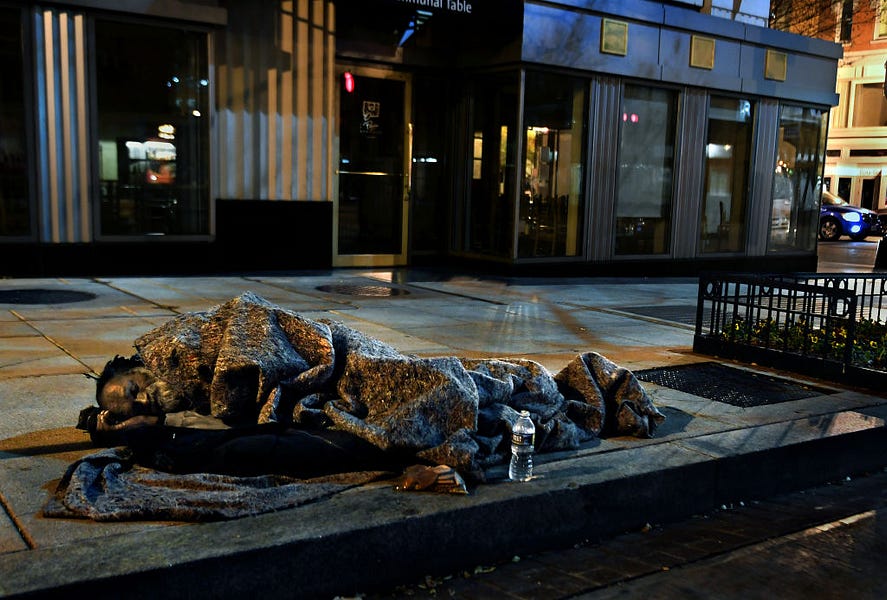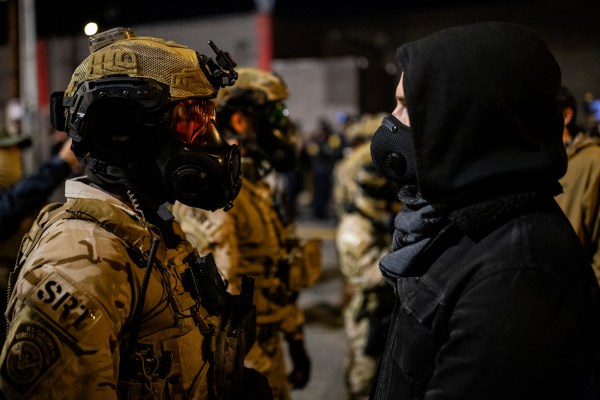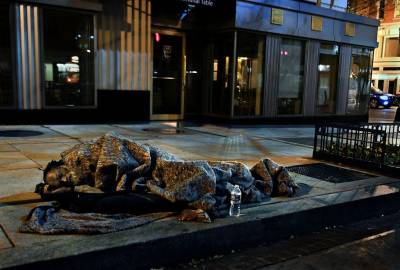One of the most pernicious homeless encampments in Washington, D.C., sits under an overpass on 1st Street next to Union Station.
For years now, a cluster of tents, and now a couple of semi-permanent structures, have sheltered under H Street and beside the massive stone wall that supports Washington’s 1908 neoclassical masterpiece of a train station. In a city rightly acclaimed for its broad avenues and spacious urban plan, this little ditch of a street feels cramped. And with the tents and the constant presence of shuffling, obviously unwell and often deeply intoxicated people around the train station, it feels menacing, too. My work sometimes takes me down 1st Street at night on the quickest path to reach the television studios just beyond the bridge. I wouldn’t say that I am afraid when I go, but I sure keep my eyes open. And it's certainly not a place I would let my sons go for a stroll.
There, less than a mile from the Capitol and inside one of the highest-rent commercial districts in the city, sits this little clot of human misery. It is not very different from the other nylon shanty towns around Washington. At the one on 3rd Street under Interstate 695, just a stone’s throw from a new Whole Foods and luxury high rise apartments and hotels, street people have erected a privacy wall to protect them from the constant noise of one of the city’s busiest onramps. As the motors of luxury SUVs and Amazon trucks whine and roar to climb onto the gleaming, eight-lane freeway that slices through the capital city, they move past the kind of wretched squalor that should offend the conscience and decency of any American.
There, like the trench of despair by Union Station, the city has placed what were supposed to be temporary toilets, but now stand month after month and year after year. Some of these Skid Rows have been gathering spots for people living on the streets for decades, but during the coronavirus pandemic, the city moved to provide more services outdoors while shelters were shuttered and jails were turning away perpetrators of minor crimes. The city and the National Park Service have taken some steps to reclaim some public spaces since the peak of the pandemic and the resumption of full social services, but the number and size of these clusters is greater than the already significant scale before COVID-19.
Every grownup knows why the problem is so hard to solve. Drug addiction and mental illness make tent-city residents unable or unwilling to get into the public resource pipeline or to take advantage of private charity. Many who do go into the temporary housing and treatment options available repeatedly fail to find a foothold in society and slide back into sleeping on the streets. Not only do jails and police not want to deal with enforcing vagrancy laws only to see the same people out in the same places a day later, the prevailing thinking among homeless advocates in Washington and other cities is to care for those individuals where they are—providing toilets, showers, safe drug paraphernalia, etc. These camps represent the uneasy truce between the street people and official Washington. Cops will roust you if you set up camp on the National Mall or a residential street, but turn a blind eye if you are under the railroad tracks or by the entrance to a tunnel.
It’s a morally complex situation, to say the least. The individuals on the streets do not have the right to occupy common spaces meant for everyone, and these camps breed disease and provide havens for crimes far beyond shooting up drugs. But what should a compassionate society do about people who are unable to care for themselves? We can’t keep them in prison for vagrancy forever, and our mental health system is a shattered shambles that couldn’t provide beds for them all even if prosecutors and courts were more inclined to seek involuntary commitments. Groups helping homeless families with children have great success stories, but for the single, mostly male individuals who make up the majority of those living on the streets, the statistics are grim. What kind of national or even citywide policies would best address the problem in a systematic way? So far, we’ve utterly failed.
One of the buildings that form the little canyon where these shattered men reside on 1st Street is home to two groups that play significant roles in how America approaches homelessness: The American Psychological Association and the National Association of Social Workers are both in the sprawling, 12-story building at the corner of 1st Street and G Street. To go in or out of the building, one would have to walk around the wretched places where people have been squatting for years. Organizations devoted to the professions that deal with mental illness and individuals in crisis coexist with this powerful evidence of failure of the systematic approach that most of us would prefer. The problem has, literally, arrived at their doorstep.
I am sure it pains social workers and psychologists to see the misery outside their offices, but that misery is also proof of the ways in which systematic and institutional thinking is unequal to the plight of individual humans. We cannot ever entirely banish homelessness because we cannot banish human nature. Even in systems with carefully crafted, well-funded systems to help those in need, some people will defeat the best intentions of everyone involved.
America is very much in need of stronger institutions—from Congress, to schools, to faith groups, to companies, and on and on—in the hopes that those places will produce better policies and systems. But we also want strong institutions to produce more virtuous people who can fill in the places where even the best policies and systems cannot reach. Systematic thinking is necessary, but we have to remind ourselves that it also makes it harder to see individuals and the debt of love we owe each other.







Please note that we at The Dispatch hold ourselves, our work, and our commenters to a higher standard than other places on the internet. We welcome comments that foster genuine debate or discussion—including comments critical of us or our work—but responses that include ad hominem attacks on fellow Dispatch members or are intended to stoke fear and anger may be moderated.
With your membership, you only have the ability to comment on The Morning Dispatch articles. Consider upgrading to join the conversation everywhere.